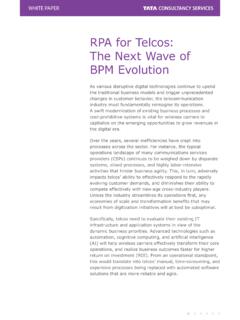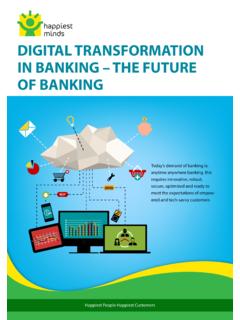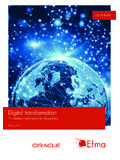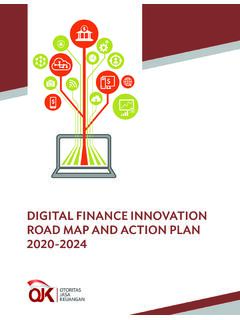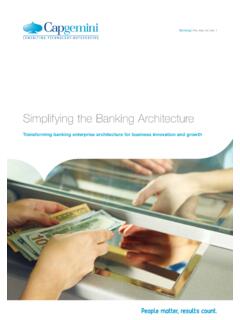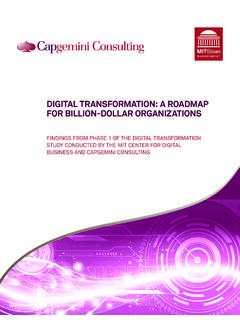Transcription of Impact of COVID-19 on Digital Payments - TCS
1 Preparing for the Post COVID-19 World: Implications for Global Payments banking & Financial Services PURPOSE-DRIVEN RESILIENT ADAPTABLE. Abstract The COVID-19 crisis presents unforeseen under-developed and developing challenges to global economies in the countries will have long term implications immediate, short, and long term. Even as for future economic growth. This white countries fight this unprecedented paper describes the Impact on payment challenge, the response has clearly outlined firms and outlines ways in which the the lack of resilience at the macro level. The industry can respond to the challenges and sharp decline in global trade, trimming of ensure the delivery of seamless payment personal consumption, difficulties in services. accessing credit, liquidity crunch, disrupted income streams, increase in bad debts, lowered cross-border remittances, and lack of access to finance especially in PURPOSE-DRIVEN RESILIENT ADAPTABLE.
2 COVID-19 : How Payment Firms Must Adapt Payments constitute the backbone of a nation's economy. The role of the Payments industry has assumed critical importance in the prevailing pandemic situation with more and more people switching to online methods to purchase essentials and other necessities. Despite the scale of the emergency, payment market infrastructures, schemes, remittance operators, and payment processing systems of banks alike have demonstrated resilience ensuring continuous availability and stability of payment services. How this pandemic will influence Payments and the global economics is not fully certain, but the volume growth will either be muted or lower than anticipated. In situations where contactless' is key to prevent the transmission of the virus, digitalization will assume center stage in the post-pandemic scenario.
3 At the same time, payment firms will need to come closer to their customers to reaffirm the trust placed in their brands by customers. In our view, payment firms with strong fundamentals and focus on Digital Payments are most likely to emerge as leaders in the post-COVID era. As the industry navigates through the pandemic, payment players will need to define their response across four phases that may overlap: Immediate-term: ensure availability and stability of the IT systems as continuous access to immediate funds is key Short-term: identify the most frequently used services, analyze consumer spend behavior, and design an action plan to extend services over the right Digital channels Medium-term: focus on expansion of Digital services and interactions to enhance customer affinity; leverage the power of open banking to expand the charter for Digital services and innovations Long-term: focus on strategic business continuity improvements and supporting a Digital -only organization strategy Emerging Trends: What Banks Must Do Given the far-reaching Impact that COVID-19 will have on the Payments space, we believe that banks would do well to expand access to Digital touchpoints underpinned by stability, security, availability, and reliability in the immediate term.
4 Investments in payment digitalization to go up Relationship between corporates and banks to become deeper The COVID-19 crisis will result in a spike in Digital transactions as There are already several economies where the interactions between evidenced by PayPal reporting their highest ever transaction volume in consumers and businesses are completely digitized for funds movement history on May 1, 20201, and registering an addition of million net new no matter the underlying purpose. For instance, disbursement and active (NNA) accounts during April Banks will need to ensure collection of taxes, payment of dividends, direct government benefit scalable infrastructure to meet the increased demand. Even before the transfers, payment collections, and escrow Payments are completely onset of COVID-19 , global banks had been investing heavily in digitalizing digitized.
5 Given the COVID-19 pandemic is driving a shift to online the Payments value chains. Digitalization initiatives, however, have largely Payments , the provision of fully Digital options for consumer-to-business revolved around achieving compliance with regulations such as Open (C2B) and business-to-business (B2B) will fast emerge as a key imperative banking , aimed at fostering innovation and competition. in the context of commercial banking . Banks can use the move to the ISO. 20022 messaging standard and initiatives such as request-to-pay to Since its launch in the UK and Europe in early 2015, Open banking has support interactions between corporations and their customers to create spread to other countries. Some economies such as those in the ASEAN Digital channel to facilitate seamless funds transfer.
6 Region took the digitalization initiative a lot further to bring about harmonization and interoperability of Digital frameworks. These successes have already shown how digitalization and openness can support the needs of a post- COVID-19 era. This would mean that corridors that have embraced Open banking are likely to see cooperation and collaboration that would foster frictionless global, interconnected, cross-border commerce resilient to unforeseen conditions. This coupled with the need to reduce paper-based operations will push banks to scale up digitalization initiatives. 1. PayPal, PayPal's Q1 2020 Earnings Call, May 2020, accessed May 2020, 2. PayPal, PayPal Q1-20 Investor Update, May 2020, accessed May 2020, Financial inclusion will emerge as a top priority for both Ability to manage personal & business finances will become critical government agencies and regulators Both retail banking customers and businesses will look toward financial Consumers without access to basic banking facilities will be the most institutions for advice on how to better manage their finances and plan for affected by the pandemic.
7 Prolonged loss of employment will result in a future contingencies like the COVID-19 pandemic. Banks must offer severe cash crunch and plans are already afoot to extend government personal financial management (PFM) services and help customers benefits and emergency funds to vulnerable sections. India and Sweden manage their changed financial situations. To achieve this, banks will need have successfully leveraged Digital IDs to substantially reduce the to ramp up PFM solutions by embracing analytics frameworks to derive under-banked and unbanked populace and taken steps toward a cashless crucial customer insights, anticipate emerging needs in the post- COVID-19 economy. Regulators will need to assess how they can enhance regulation phase, and craft products to meet those needs. These initiatives need to to further support Digital account opening to expedite access to banking be accelerated and banks must quickly open data access in areas not facilities and drive financial inclusion.
8 Banks must grab this opportunity governed by Open banking and Payment Services Directive 2 (PSD2). and take steps to bring the underserved and unbanked population into Regulators across the globe must act quickly by extending Open banking the formal banking fold, in turn expanding customer base for their data sharing principles through the Open Finance initiative, especially as products and services. PFM solutions underpinned by data analytics will likely see greater global uptake as the world comes out of the pandemic. Participants will continue to deploy robust and resilient Cyber surveillance, cybersecurity and financial crime management infrastructures, albeit at a different pace will become paramount Payment stakeholders are already amid multiple engagements to The uncertain times created by the COVID-19 pandemic present implement future-proof, highly resilient infrastructures and multi-currency opportunities for fraudsters to strike at the vulnerable layers of the clearing schemes.
9 However, these programs are still far from completion organization. Banks must step up surveillance mechanisms to detect and remote working is likely to further delay them. However, banks must threats across multiple organizational layers. Given that the ability to fully embrace remote working solutions to ensure that change programs seamlessly and easily make Payments is especially important in the remain on track as infrastructure improvement initiatives remain critical to prevailing situation, banks must reassess and monitor the effectiveness of adequately support Digital customer engagement and Digital payment threat identification and management processes and establish adequate volume growth in the post pandemic phase. controls. Greater uptake of Digital currencies In the post-COVID era, research into the options to transform paper currency into Digital forms will accelerate.
10 Several countries are already experimenting with central bank Digital currencies (CBDCs), and we believe that it could become a reality as early as 2021. We expect retail Payments to be the first to switch to Digital currencies as opposed to high value transfers. Should this become a reality, banks will need to review their current payment infrastructure to ensure that they have the capabilities necessary to implement CBDC payment methods. In a Nutshell There is no clarity on when the COVID-19 crisis will abate or its effects on our societies and businesses. However, it is indisputable that this unforeseen pandemic will have far greater Impact globally than the 2008 crisis and economies will take longer to turn around. As countries relax lockdown measures and open for business, consumers and businesses will rely on electronic payment methods more than ever.


